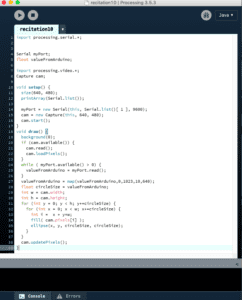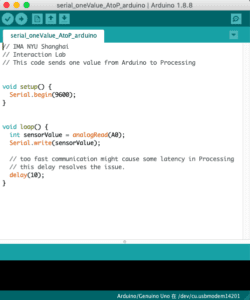For Sunday’s recitation, I tried to use potentiometer to control the size of the circles, in other word, pixels of the webcam. So, firstly, I built the circuit and used the monitor to test if it worked. I used the code from the slides and added one sentence “Serial.println(sensorValue);”. It turned out that the values were correct but there were weird signs before the values. For example, “?455”, “#710”. Then I asked Nick for help. He pointed out that in the code, there appeared to be “Serial.write(sensorValue);” before the code I just added in. I remember the difference of “serial.write();” and “serial.println();” because I have made this mistake on class exercise before. They speak two different languages! And that’s why there were actually two type of values on the monitor – they were actually sending the same messages, but in different languages. Hence, I deleted the code I added.
For the Processing part, I used the code of example 11 from the “Pixel Manipulation” class. I mapped the value from 0-1023 to 0-480 to fit the cam size and changed the circle size to the value from Arduino. However, when I tested the code, it didn’t work well when the value from Arduino became smaller. Later I found that it is not appropriate to map the smallest value as 0. The pixel can’t be zero. Thus, I changed it to 10. And it worked as I expected.
CODE:


Reflection:
In the article “Computer Vision for Artists and Designers: Pedagogic Tools and Techniques for Novice Programmers“, visualization could be defined as one of the key concepts. Similarly, visualization is also a key concept in my final project. In the article, it is mentioned that the computer vision is now widespread in different fields like interactive arts and design. In my own point of view, vision is the most direct way for interaction. What we see is objective, but what everyone receives is subjective. So, here is one thing I find quite interesting about because there’s always different meanings, thoughts behind single view for every individual. Also, I think that vision can be easily mixed and connected with other type of expressions, such as music. Just as the project mentioned in the article, “Messa di Voce”, the usage of “whole-body vision-based interactions combines visions with speech analysis and situates them within a kind of projection-based augmented reality.” This kind of combination maximizes the interactive elements in the project and brings the audiences huge satisfaction.